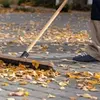A crack has appeared in your paving stone: what can you do?
- Date : Tuesday, March 18th, 2025
- Read time : 3 min
Uni-stone is an aesthetic and durable choice for landscaping. However, with the passage of time and Quebec's climatic conditions, cracks can appear. Don't panic! Here's a quick guide to understanding the origin of cracks and how to repair them effectively.
Why are cracks appearing in the paving?
Cracks in pavers can be caused by a number of factors:
- Freeze-thaw cycles Water that seeps under paving stones can freeze in winter, causing the soil to expand, which creates stress and can lead to cracking.
- Ground subsidence If the base beneath the pavers has not been properly compacted, or if drainage is inadequate, certain areas may sink and lead to cracking.
- Natural wear and tear Frequent use by heavy vehicles, erosion and prolonged exposure to the elements can weaken some pavers and lead to cracking.
- Tree roots Root growth can displace and crack paving over time.
How do I repair a crack in the paving stone?
Assessing the scale of the problem
Before undertaking any repairs, observe the crack:
- Is itsurface or does it affect several paving stones?
- Is there avisible subsidence around the crack?
- Does the crack widen over time?
Filling a minor crack
If the crack is small and the paving stones are still firmly in place:
✔Clean the crack with a brush and remove all dust and debris.
✔Apply polymer sand into the crack, then moisten to solidify and prevent water infiltration.
✔Add a protective sealant to extend the life of the pad.
Replace or reposition cracked pavers
For larger cracks or broken paving stones:
✔Remove damaged pavers using a lever or paving extractor.
✔Check the base under the pavers and add gravel or compacted sand if necessary.
✔Replace the paverslevel and apply polymer sand to stabilize the whole.
Correcting ground subsidence
If the crack is caused by subsidence, it is crucial to intervene in depth:
✔Lift the paving stones from the affected area.
✔Add a new foundation layer (compacted gravel) to solidify the base.
✔Replace pavers and level properly.
✔Add polymer sand and seal it all together.
How can I prevent cracks in paving stones?
Ensure good drainage
Well-drained soil reduces the risk of movement caused by water and frost.
Apply a protective sealant
A good sealant protects pavers from erosion and water infiltration.
Watch out for tree roots
Avoid planting trees with invasive roots too close to your pavement.
Perform regular maintenance
Check the joints and apply polymer sand if necessary to stabilize the pavers.
If your paving stone shows significant cracks or pronounced settling, it may be a good idea to call in the professionals.Regimbald layout has all the expertise needed to analyze, repair and prevent paving-related problems to ensure long-lasting, aesthetically pleasing landscaping.





